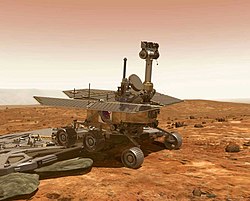MAVEN
| MAVEN | |||||||||||||||||||
|---|---|---|---|---|---|---|---|---|---|---|---|---|---|---|---|---|---|---|---|
 Missionslogo | |||||||||||||||||||
| NSSDC ID | 2013-063A | ||||||||||||||||||
| Missionsziel | Mars | ||||||||||||||||||
| Betreiber | |||||||||||||||||||
| Trägerrakete | Atlas V (401) AV-038 | ||||||||||||||||||
| Startmasse | 2454 kg | ||||||||||||||||||
| Verlauf der Mission | |||||||||||||||||||
| Startdatum | 18. November 2013, 18:28 UTC | ||||||||||||||||||
| Startrampe | Cape Canaveral, LC-41 | ||||||||||||||||||
| |||||||||||||||||||
Mars Atmosphere and Volatile Evolution (MAVEN) ist eine Raumsonde zur Erforschung der Atmosphäre des Planeten Mars im Rahmen des Mars-Scout-Programms der NASA. Die Sonde wurde am 18. November 2013 mit einer Atlas-V-Rakete erfolgreich gestartet,[2][3] umkreist seit dem 22. September 2014 den Mars und führte vier Tiefflüge durch die Atmosphäre durch.[4]
Hintergrund
Am 15. September 2008 gab die NASA bekannt, dass sie für das Jahr 2013 den Projektvorschlag MAVEN als Mars-Scout-2-Mission ausgewählt habe.[5] Die Auswahl erfolgte gegen den Finalisten „The Great Escape“, ebenfalls eine Atmosphärenforschungsmission. Diese beiden Missionen waren aus ursprünglich acht Vorschlägen ausgewählt worden. Die Projektkosten für MAVEN betragen 485 Millionen US-Dollar.
Die Mission wurde am 3. Oktober 2013 als eine der wenigen NASA-Aktivitäten von dem Government Shutdown 2013 ausgeschlossen, um den geplanten Start nicht zu gefährden.[6]
Struktur
Die Struktur der Raumsonde basiert auf den Konstruktionen der Raumsonden Mars Reconnaissance Orbiter und 2001 Mars Odyssey.
Instrumentierung

MAVEN soll die obere Atmosphäre des Mars und deren Interaktion mit der Sonne untersuchen. Zu diesem Zweck sind Instrumente zur Erfassung der Charakteristiken der atmosphärischen Gase, der oberen Atmosphäre, des Sonnenwinds und der Ionosphäre an Bord.[7] Die University of Colorado Boulder, die University of California und das Goddard Space Flight Center bauten die Instrumente für MAVEN.
Missionsverlauf

MAVEN startete mit einer Atlas V (401) vom Startkomplex 41 (Cape Canaveral) am 18. November 2013[3] und erreichte den Mars am 22. September 2014.[1] MAVEN schwenkte in eine hochelliptische Umlaufbahn ein, die zwischen 144 km und 6228 km über der Planetenoberfläche verläuft. Am 6. November 2014 übertrug MAVEN als Repeater mehrere Bilder des Rovers Curiosity zum Deep Space Network, als sich MAVEN im Orbit über Curiosity befand.[8]
MAVEN führte während seiner Mission vier so genannte „Deep Dip“-Manöver durch.[4] Dafür wurde MAVENs Periapsis auf 125–150 km abgesenkt. Die Sonde fliegt dann durch die obersten Schichten der Atmosphäre und kann diese mit ihren wissenschaftlichen Instrumenten untersuchen. Am 6. Februar 2015 durchflog MAVEN die abendliche Terminatorregion,[9] am 10. April 2015 die Subpolarregion,[10] am 26. Juni 2015 die Region des morgendlichen Terminators und schließlich am 21. August 2015 die Südpolarregion.[11] Die Primärmission endete im November 2015, die Mission wurde aber verlängert.
Zwischen dem 11. Februar und dem 5. April 2019 wurde die Umlaufbahn durch gezielte Atmosphärenbremsung abgesenkt. Der marsnähste Punkt des Orbits näherte sich von 151 km auf 132 km über der Oberfläche, der marsfernste von 6050 auf 4570 km. Dadurch verringerte sich die Umlaufzeit, so dass MAVEN öfter als bisher Kontakt zu den Marsrovern aufnehmen und als Kommunikationsrelais dienen konnte. MAVEN untersucht weiterhin die Atmosphäre. Der Treibstoff wird noch für einen Betrieb bis mindestens 2030 reichen.[12]
Siehe auch
- Liste der Raumsonden
- Maven – angelehnte sprachliche Bedeutung
Weblinks
- MAVEN auf www.nasa.gov
- raumfahrer.net: Mit MAVEN zum Mars
Einzelnachweise
- ↑ a b NASA: NASA’s Newest Mars Mission Spacecraft Enters Orbit around Red Planet. In: NASA Press Release 14-260. 21. September 2014, abgerufen am 23. September 2014 (englisch, Der Eintritt erfolgte am 22. September um 02:24 UTC, in den USA war noch der 21. September, dies wird von der NASA sowohl für das Eintrittsdatum als auch für das Datum der Presseerklärung verwendet).
- ↑ NASA: The MAVEN Mission. 18. November 2013, abgerufen am 23. September 2014 (englisch).
- ↑ a b Michael Clormann: MAVEN ist auf dem Weg zum Mars. raumfahrer.net, 18. November 2013, abgerufen am 23. September 2014.
- ↑ a b NASA's MAVEN Celebrates One Year at Mars. 22. September 2015, abgerufen am 12. Dezember 2015.
- ↑ NASA Selects 'MAVEN' Mission to Study Mars Atmosphere. NASA, 15. September 2008, abgerufen am 12. März 2012 (englisch).
- ↑ Maven "Excepted" From Shutdown. NasaWatch, abgerufen am 15. Oktober 2012 (englisch).
- ↑ CU chosen for $485M Mars exploration project. Thr Denver Post, 15. September 2008, abgerufen am 2. August 2023 (englisch).
- ↑ Newest NASA Mars Orbiter Demonstrates Relay Prowess. NASA, abgerufen am 2. Januar 2015 (englisch).
- ↑ NASA Spacecraft Takes 'Deep Dip' Into Martian Upper Atmosphere. 27. März 2015, abgerufen am 12. Dezember 2015.
- ↑ Structure and composition of the neutral upper atmosphere of Mars from the MAVEN NGIMS investigation. Abgerufen am 12. Dezember 2015.
- ↑ Udo Günther: Mavens erstes Deep Dip Manöver. marspages.eu, 29. November 2014, archiviert vom (nicht mehr online verfügbar) am 22. Dezember 2014; abgerufen am 29. November 2014.
- ↑ Nancy Neal Jones: MAVEN Uses Red Planet’s Atmosphere to Change Orbit. NASA’s Goddard Space Flight Center, 5. April 2019, abgerufen am 1. September 2020 (englisch).
Auf dieser Seite verwendete Medien
The United Launch Alliance Atlas V rocket with NASA’s Mars Atmosphere and Volatile Evolution (MAVEN) spacecraft launches from the Cape Canaveral Air Force Station Space Launch Complex 41, Monday, Nov. 18, 2013, Cape Canaveral, Florida. NASA’s Mars-bound spacecraft, the Mars Atmosphere and Volatile EvolutionN, or MAVEN, is the first spacecraft devoted to exploring and understanding the Martian upper atmosphere.
September 17, 2014
RELEASE 14-254
NASA Mars Spacecraft Ready for Sept. 21 Orbit Insertion orbital insertion of NASA’s Mars Atmosphere and Volatile Evolution (MAVEN) spacecraft
[IMAGE] This artist concept depicts the process of orbital insertion of NASA’s Mars Atmosphere and Volatile Evolution (MAVEN) spacecraft. Image Credit: NASA/GSFC
NASA’s Mars Atmosphere and Volatile Evolution (MAVEN) spacecraft is nearing its scheduled Sept. 21 insertion into Martian orbit after completing a 10-month interplanetary journey of 442 million miles. Flight Controllers at Lockheed Martin Space Systems in Littleton, Colorado, will be responsible for the health and safety of the spacecraft throughout the process. The spacecraft’s mission timeline will place the spacecraft in orbit at approximately 9:50 p.m. EDT.
“So far, so good with the performance of the spacecraft and payloads on the cruise to Mars,” said David Mitchell, MAVEN project manager at NASA’s Goddard Space Flight Center in Greenbelt, Maryland. “The team, the flight system, and all ground assets are ready for Mars orbit insertion.”
The orbit-insertion maneuver will begin with the brief firing of six small thruster engines to steady the spacecraft. The engines will ignite and burn for 33 minutes to slow the craft, allowing it to be pulled into an elliptical orbit with a period of 35 hours.
Following orbit insertion, MAVEN will begin a six-week commissioning phase that includes maneuvering the spacecraft into its final orbit and testing its instruments and science-mapping commands. Thereafter, MAVEN will begin its one-Earth-year primary mission to take measurements of the composition, structure and escape of gases in Mars’ upper atmosphere and its interaction with the sun and solar wind.
“The MAVEN science mission focuses on answering questions about where did the water that was present on early Mars go, about where did the carbon dioxide go,” said Bruce Jakosky, MAVEN principal investigator from the University of Colorado, Boulder's Laboratory for Atmospheric and Space Physics. “These are important questions for understanding the history of Mars, its climate, and its potential to support at least microbial life.”
MAVEN launched Nov. 18, 2013, from Cape Canaveral, Florida, carrying three instrument packages. It is the first spacecraft dedicated to exploring the upper atmosphere of Mars. The mission’s combination of detailed measurements at specific points in Mars’ atmosphere and global imaging provides a powerful tool for understanding the properties of the Red Planet’s upper atmosphere.
“MAVEN is another NASA robotic scientific explorer that is paving the way for our journey to Mars,” said Jim Green, director of the Planetary Science Division at NASA Headquarters in Washington. “Together, robotics and humans will pioneer the Red Planet and the solar system to help answer some of humanity’s fundamental questions about life beyond Earth.”
The spacecraft’s principal investigator is based at the Laboratory for Atmospheric and Space Physics at University of Colorado, Boulder. The university provided two science instruments and leads science operations, as well as education and public outreach, for the mission.
NASA Goddard Space Flight Center in Greenbelt, Maryland, manages the project and also provided two science instruments for the mission. Lockheed Martin built the spacecraft and is responsible for mission operations. The Space Sciences Laboratory at the University of California at Berkeley provided four science instruments for MAVEN. NASA's Jet Propulsion Laboratory in Pasadena, California, provides navigation and Deep Space Network support, and Electra telecommunications relay hardware and operations.
To learn more about the MAVEN mission, visit:
http://www.nasa.gov/mavenIcon für eine vertikale Zeitleiste
MAVEN instrument : Solar Wind Electron Analyzer (SWEA)
Icon für eine vertikale Zeitleiste
Icon für eine vertikale Zeitleiste
Icon für eine vertikale Zeitleiste
The Mars Atmosphere and Volatile Evolution, or MAVEN, mission is being prepared for its scheduled launch on Nov 18, 2013 from Cape Canaveral Air Force Station, Fla. atop a United Launch Alliance Atlas V rocket. Positioned in an orbit above the Red Planet, MAVEN will study the upper atmosphere of Mars in unprecedented detail. It will arrive at Mars in fall 2014. After a five-week transition period during which it will get into its final orbit, deploy booms, and check out the science instruments, MAVEN will carry out its one-Earth-year primary mission. MAVEN will have enough fuel to survive for another six years and will act as a data relay for spacecraft on the surface, as well as continue to take important science data. MAVEN's principal investigator is based at the University of Colorado, Boulder's Laboratory for Atmospheric and Space Physics CU/LASP. The university provided science instruments and leads science operations, as well as education and public outreach, for the mission. NASA Goddard Space Flight Center NASA GSFC, Greenbelt, Md. manages the project and provided two of the science instruments for the mission. The University of California at Berkeley's Space Sciences Laboratory UCB/SSL provided science instruments for the mission. Lockheed Martin LM built the spacecraft and is responsible for mission operations. NASA's Jet Propulsion Laboratory NASA JPL in Pasadena, Calif., provides navigation support, Deep Space Network support, and Electra telecommunications relay hardware and operations.











